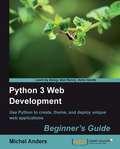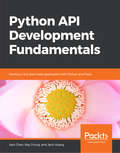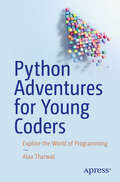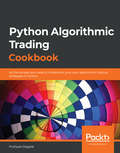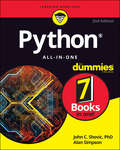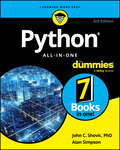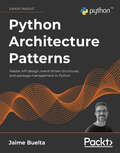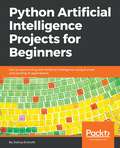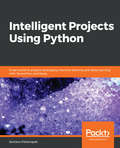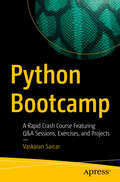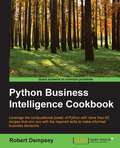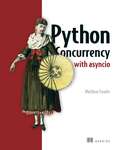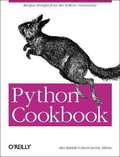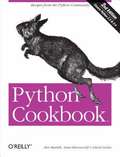- Table View
- List View
Python 3 Web Development Beginner's Guide
by Michel AndersPart of Packt's Beginner's Guide Series, this book follows a sample application, with lots of screenshots, to help you get to grips with the techniques as quickly as possible. Moderately experienced Python programmers who want to learn how to create fairly complex, database-driven, cross browser compatible web apps that are maintainable and look good will find this book of most use. All key technologies except for Python 3 are explained in detail.
Python API Development Fundamentals: Develop a full-stack web application with Python and Flask
by Jack Chan Ray Chung Jack HuangLearn all that's needed to build a fully functional web application from scratch. Key Features Delve deep into the principle behind RESTful API Learn how to build a scalable web application with the RESTful API architecture and Flask framework Know what are the exact tools and methodology to test your applications and how to use them Book Description Python is a flexible language that can be used for much more than just script development. By knowing the Python RESTful APIs work, you can build a powerful backend for web applications and mobile applications using Python. You'll take your first steps by building a simple API and learning how the frontend web interface can communicate with the backend. You'll also learn how to serialize and deserialize objects using the marshmallow library. Then, you'll learn how to authenticate and authorize users using Flask-JWT. You'll also learn how to enhance your APIs by adding useful features, such as email, image upload, searching, and pagination. You'll wrap up the whole book by deploying your APIs to the cloud. By the end of this book, you'll have the confidence and skill to leverage the power of RESTful APIs and Python to build efficient web applications. What you will learn Understand the concept of a RESTful API Build a RESTful API using Flask and the Flask-Restful extension Manipulate a database using Flask-SQLAlchemy and Flask-Migrate Send out plaintext and HTML format emails using the Mailgun API Implement a pagination function using Flask-SQLAlchemy Use caching to improve API performance and efficiently obtain the latest information Deploy an application to Heroku and test it using Postman Who this book is for This book is ideal for aspiring software developers who have a basic-to-intermediate knowledge of Python programming and who want to develop web applications using Python. Knowledge of how web applications work will be beneficial but is not essential.
Python Adventures for Young Coders: Explore the World of Programming
by Alaa TharwatThis book takes young readers on an exciting adventure with a child named Kai. One day, Kai wakes up trapped inside a giant robot. He can't talk to anyone outside, and the only way to communicate is through the robot. Inside the robot, Kai finds many books and documents written in a strange language—it's the robot's language, which is Python. Kai realizes he needs to learn this language to control the robot and talk to the outside world. In each chapter in this book, we will join Kai on a new adventure to learn something that helps us control the robot better and communicate with the real world. This fun and interactive book is designed to introduce young minds to the basics of programming while encouraging creativity and problem-solving skills. In the introductory chapters, readers discover Python as a friendly and accessible programming language. The book guides them through setting up their programming environment and crafting their initial lines of code, laying the foundation for an exciting coding adventure. As the exploration unfolds, it delves into fundamental programming concepts essential for any budding coder. From variables and data types to loops and conditionals, these building blocks empower readers to create their programs, fostering a solid understanding of the core principles of coding. It seamlessly integrates these concepts with previously learned fundamentals, providing a comprehensive view of Python's capabilities. Fueling creativity, it inspires readers to unleash their imagination through engaging projects. From crafting games to developing useful applications, young coders learn to apply their programming skills in innovative ways, transforming abstract coding concepts into real and interactive projects. With a focus on accessibility, engagement, and real-world application, this book paves the way for the next generation of Python enthusiasts. What you will learn: Understand Python programming fundamentals, including syntax, variables, data types, loops, conditionals, lists, functions, and handling files. Learn to break down complex problems into smaller, manageable tasks and apply coding concepts to find creative solutions. How to create their interactive coding projects using Python. Understand strategies for debugging and troubleshooting common programming problems, which are essential skills for any programmer Who this book is for: This book caters primarily for high school students and individuals keen on delving into programming with minimal or zero coding background. It's structured to be both accessible and captivating for young readers, immersing them in the realm of coding through entertaining and interactive journeys. Moreover, it extends its reach to educators and coding enthusiasts alike.
Python Algorithmic Trading Cookbook: All The Recipes You Need To Implement Your Own Trading Strategies In Python
by Pushpak DagadeIf you are a financial analyst, financial trader, data analyst, or algorithmic trader who wants to learn algorithmic trading techniques to address challenges faced in the finance domain, then this book is for you. Basic knowledge of financial terminologies and working knowledge of the Python programming language are expected.
Python Algorithms
by Magnus Lie HetlandPython Algorithms, Second Edition explains the Python approach to algorithm analysis and design. Written by Magnus Lie Hetland, author of Beginning Python, this book is sharply focused on classical algorithms, but it also gives a solid understanding of fundamental algorithmic problem-solving techniques. The book deals with some of the most important and challenging areas of programming and computer science in a highly readable manner. It covers both algorithmic theory and programming practice, demonstrating how theory is reflected in real Python programs. Well-known algorithms and data structures that are built into the Python language are explained, and the user is shown how to implement and evaluate others.
Python All-in-One For Dummies
by Alan Simpson John ShovicYour one-stop resource on all things Python Thanks to its flexibility, Python has grown to become one of the most popular programming languages in the world. Developers use Python in app development, web development, data science, machine learning, and even in coding education classes. There's almost no type of project that Python can't make better. From creating apps to building complex websites to sorting big data, Python provides a way to get the work done. Python All-in-One For Dummies offers a starting point for those new to coding by explaining the basics of Python and demonstrating how it’s used in a variety of applications. Covers the basics of the language Explains its syntax through application in high-profile industries Shows how Python can be applied to projects in enterprise Delves into major undertakings including artificial intelligence, physical computing, machine learning, robotics and data analysis This book is perfect for anyone new to coding as well as experienced coders interested in adding Python to their toolbox.
Python All-in-One For Dummies
by Alan Simpson John C. ShovicThe one-stop resource for all your Python queries Powerful and flexible, Python is one of the most popular programming languages in the world. It’s got all the right stuff for the software driving the cutting-edge of the development world—machine learning, robotics, artificial intelligence, data science, etc. The good news is that it’s also pretty straightforward to learn, with a simplified syntax, natural-language flow, and an amazingly supportive user community. The latest edition of Python All-in-One For Dummies gives you an inside look at the exciting possibilities offered in the Python world and provides a springboard to launch yourself into wherever you want your coding career to take you. These 7 straightforward and friendly mini-books assume the reader is a beginning programmer, and cover everything from the basic elements of Python code to introductions to the specific applications where you’ll use it. Intended as a hands-on reference, the focus is on practice over theory, providing you with examples to follow as well as code for you to copy and start modifying in the “real world”—helping you get up and running in your area of interest almost right away. This means you’ll be finishing off your first app or building and remote-controlling your own robot much faster than you can believe. Get a thorough grounding in the language basics Learn how the syntax is applied in high-profile industries Apply Python to projects in enterprise Find out how Python can get you into hot careers in AI, big data, and more Whether you’re a newbie coder or just want to add Python to your magic box of tricks, this is the perfect, practical introduction—and one you’ll return to as you grow your career.
Python All-in-One For Dummies
by Alan Simpson John C. ShovicEverything you need to know to get into Python coding, with 7 books in one Python All-in-One For Dummies is your one-stop source for answers to all your Python questions. From creating apps to building complex web sites to sorting big data, Python provides a way to get the work done. This book is great as a starting point for those new to coding, and it also makes a perfect reference for experienced coders looking for more than the basics. Apply your Python skills to data analysis, learn to write AI-assisted code using GitHub CoPilot, and discover many more exciting uses for this top programming language. Get started coding in Python—even if you’re new to computer programming Reference all the essentials and the latest updates, so your code is air-tight Learn how Python can be a solution for large-scale projects and big datasets Accelerate your career path with this comprehensive guide to learning PythonExperienced and would-be coders alike will love this easy-to-follow guide to learning and applying Python.
Python Alles-in-einem-Band für Dummies (Für Dummies)
by Johannes C. HofmeisterPython programmieren lernen lohnt sich. Es ist eine moderne sich ständig weiterentwickelnde Programmiersprache. Dieses Buch hilft Ihnen, wenn Sie Python von der Pike auf lernen wollen, aber auch mehr als nur die Grundlagen verstehen wollen. Johannes Hofmeister erklärt Ihnen Grundlagen wie Syntax, Module und Basic-Funktionen und schreitet dann zu fort zu höheren Konzepten wie Funktionen und Objekte. Er zeigt Ihnen auch, wie Sie diese testen können, um fehlerfrei Software zu schreiben. Danach widmet sich der Autor Internettechnologien wie E-Mail, Apis und Browsing und erklärt Ihnen, wie Sie mit Django eine Webanwendung bauen. Sie erfahren, wie Sie mithilfe von Python komplexe Datensätze analysieren und zuletzt beweist Ihnen der Autor, wie vielseitig nutzbar Python ist.
Python Architecture Patterns: Master API design, event-driven structures, and package management in Python
by Jaime BueltaMake the best of your test suites by using cutting-edge software architecture patterns in PythonKey FeaturesLearn how to create scalable and maintainable applicationsBuild a web system for micro messaging using concepts in the bookUse profiling to find bottlenecks and improve the speed of the systemBook DescriptionDeveloping large-scale systems that continuously grow in scale and complexity requires a thorough understanding of how software projects should be implemented. Software developers, architects, and technical management teams rely on high-level software design patterns such as microservices architecture, event-driven architecture, and the strategic patterns prescribed by domain-driven design (DDD) to make their work easier. This book covers these proven architecture design patterns with a forward-looking approach to help Python developers manage application complexity—and get the most value out of their test suites. Starting with the initial stages of design, you will learn about the main blocks and mental flow to use at the start of a project. The book covers various architectural patterns like microservices, web services, and event-driven structures and how to choose the one best suited to your project. Establishing a foundation of required concepts, you will progress into development, debugging, and testing to produce high-quality code that is ready for deployment. You will learn about ongoing operations on how to continue the task after the system is deployed to end users, as the software development lifecycle is never finished. By the end of this Python book, you will have developed "architectural thinking": a different way of approaching software design, including making changes to ongoing systems.What you will learnThink like an architect, analyzing software architecture patternsExplore API design, data storage, and data representation methodsInvestigate the nuances of common architectural structuresUtilize and interoperate elements of patterns such as microservicesImplement test-driven development to perform quality code testingRecognize chunks of code that can be restructured as packagesMaintain backward compatibility and deploy iterative changesWho this book is forThis book will help software developers and architects understand the structure of large complex systems and adopt architectural patterns that are scalable. Examples in the book are implemented in Python so a fair grasp of basic Python concepts is expected. Proficiency in any programming languages such as Java or JavaScript is sufficient.
Python Arithmetic: The Informational Nature of Numbers (Studies in Big Data #153)
by Vincenzo MancaThe book is a gentle introduction to Python using arithmetic, and vice versa, with a historical perspective encompassing programming languages within the wider process of development of mathematical notation. The revisitation of typical algorithms that are the core of elementary mathematical knowledge helps to grasp their essence and to clarify some assumptions that are often taken for granted but are very profound and of a very general nature. The first mathematician to define a systematic system for generating numbers was Archimedes of Syracuse in the third century B.C. The Archimedean system, which was defined in a book with the Latin title Arenarius, was not intended to define all numbers, but only very large numbers [13, 22, 23]. However, it can be considered the first system with the three main characteristics of a counting system that have the most important properties for complete arithmetic adequacy: creativity, infinity, and recursion. Creativity means that each numeral is new for numerals that precede it; infinity means that after any numeral there is always another numeral; recursion means that after an initial sequence of numerals coinciding with the digits of the system, digits repeat regularly in all subsequent numerals. Since the numerals are finite expressions of digits, their lengths increase along their generation. In the next chapter, Python is briefly introduced by linking this language to standard mathematical notation, which took its current form throughout a long process that extends from the introduction of decimal numerals to the eighteenth century, particularly within Euler’s notational and conceptual framework. The third chapter is devoted to counting algorithms, showing that something that is usually taken for granted has intriguing aspects that deserve a very subtle analysis: the authors will show that the Python representation of counting algorithms is very informative and demonstrates the informational nature of numbers.
Python Artificial Intelligence Projects for Beginners: Get up and running with Artificial Intelligence using 8 smart and exciting AI applications
by Joshua EckrothBuild smart applications by implementing real-world artificial intelligence projectsKey FeaturesExplore a variety of AI projects with PythonGet well-versed with different types of neural networks and popular deep learning algorithmsLeverage popular Python deep learning libraries for your AI projectsBook DescriptionArtificial Intelligence (AI) is the newest technology that’s being employed among varied businesses, industries, and sectors. Python Artificial Intelligence Projects for Beginners demonstrates AI projects in Python, covering modern techniques that make up the world of Artificial Intelligence.This book begins with helping you to build your first prediction model using the popular Python library, scikit-learn. You will understand how to build a classifier using an effective machine learning technique, random forest, and decision trees. With exciting projects on predicting bird species, analyzing student performance data, song genre identification, and spam detection, you will learn the fundamentals and various algorithms and techniques that foster the development of these smart applications. In the concluding chapters, you will also understand deep learning and neural network mechanisms through these projects with the help of the Keras library.By the end of this book, you will be confident in building your own AI projects with Python and be ready to take on more advanced projects as you progressWhat you will learnBuild a prediction model using decision trees and random forestUse neural networks, decision trees, and random forests for classificationDetect YouTube comment spam with a bag-of-words and random forestsIdentify handwritten mathematical symbols with convolutional neural networksRevise the bird species identifier to use imagesLearn to detect positive and negative sentiment in user reviewsWho this book is forPython Artificial Intelligence Projects for Beginners is for Python developers who want to take their first step into the world of Artificial Intelligence using easy-to-follow projects. Basic working knowledge of Python programming is expected so that you’re able to play around with code
Python Artificial Intelligence Projects: 9 real-world AI projects leveraging machine learning and deep learning with TensorFlow and Keras
by Santanu PattanayakThis book is intended for data scientists, machine learning professionals, and deep learning practitioners who are ready to extend their knowledge and possibilities in AI. If you want to build real-life smart systems to play a crucial role in every complex domain, then this book is what you need. Knowledge of Python programming and deep learning concepts are expected to get the most out of the book.
Python Automation Cookbook: 75 Python automation ideas for web scraping, data wrangling, and processing Excel, reports, emails, and more, 2nd Edition
by Jaime BueltaGet a firm grip on the core processes including browser automation, web scraping, Word, Excel, and GUI automation with Python 3.8 and higher Key Features Automate integral business processes such as report generation, email marketing, and lead generation Explore automated code testing and Python's growth in data science and AI automation in three new chapters Understand techniques to extract information and generate appealing graphs, and reports with Matplotlib Book Description In this updated and extended version of Python Automation Cookbook, each chapter now comprises the newest recipes and is revised to align with Python 3.8 and higher. The book includes three new chapters that focus on using Python for test automation, machine learning projects, and for working with messy data. This edition will enable you to develop a sharp understanding of the fundamentals required to automate business processes through real-world tasks, such as developing your first web scraping application, analyzing information to generate spreadsheet reports with graphs, and communicating with automatically generated emails. Once you grasp the basics, you will acquire the practical knowledge to create stunning graphs and charts using Matplotlib, generate rich graphics with relevant information, automate marketing campaigns, build machine learning projects, and execute debugging techniques. By the end of this book, you will be proficient in identifying monotonous tasks and resolving process inefficiencies to produce superior and reliable systems. What you will learn Learn data wrangling with Python and Pandas for your data science and AI projects Automate tasks such as text classification, email filtering, and web scraping with Python Use Matplotlib to generate a variety of stunning graphs, charts, and maps Automate a range of report generation tasks, from sending SMS and email campaigns to creating templates, adding images in Word, and even encrypting PDFs Master web scraping and web crawling of popular file formats and directories with tools like Beautiful Soup Build cool projects such as a Telegram bot for your marketing campaign, a reader from a news RSS feed, and a machine learning model to classify emails to the correct department based on their content Create fire-and-forget automation tasks by writing cron jobs, log files, and regexes with Python scripting Who this book is for Python Automation Cookbook - Second Edition is for developers, data enthusiasts or anyone who wants to automate monotonous manual tasks related to business processes such as finance, sales, and HR, among others. Working knowledge of Python is all you need to get started with this book.
Python Automation Cookbook: Explore the world of automation using Python recipes that will enhance your skills
by Jaime BueltaStep-by-step instructions which take you through each program to automate monotonous tasks with Python 3.7Key FeaturesAutomate integral business processes such as report generation, email marketing, and lead generationBuild your first web application that scrapes data and accesses websites' APIsCreate graphic-rich charts, graphs, and maps using MatplotlibBook DescriptionHave you been doing the same old monotonous office work over and over again? Or have you been trying to find an easy way to make your life better by automating some of your repetitive tasks? Through a tried and tested approach, understand how to automate all the boring stuff using Python. The Python Automation Cookbook helps you develop a clear understanding of how to automate your business processes using Python, including detecting opportunities by scraping the web, analyzing information to generate automatic spreadsheets reports with graphs, and communicating with automatically generated emails. You’ll learn how to get notifications via text messages and run tasks while your mind is focused on other important activities, followed by understanding how to scan documents such as résumés. Once you’ve gotten familiar with the fundamentals, you’ll be introduced to the world of graphs, along with studying how to produce organized charts using Matplotlib. In addition to this, you’ll gain in-depth knowledge of how to generate rich graphics showing relevant information. By the end of this book, you’ll have refined your skills by attaining a sound understanding of how to identify and correct problems to produce superior and reliable systems.What you will learnGet to grips with scraping a website to detect changesSearch and process raw sales files to aggregate information in spreadsheetsExplore techniques to extract information from an Excel spreadsheet and generate exciting reports with graphsDiscover the techniques required to generate random, print-friendly codes to be used as single-use couponsAutomatically generate a marketing campaign, contacting the recipients over different channelsIdentify and implement precise solutionsWho this book is forThe Python Automation Cookbook is for you if you are a developer or anyone who wants to automate monotonous manual tasks related to fields such as finance, sales, and HR, among others.
Python Automation For Dummies
by Alan SimpsonStreamline Your Workflow and Boost Productivity with Python Automation In today's workplaces, there's a high demand for know-how on the Python programming language, especially for writing time-saving scripts that can simplify routine work tasks. Python Automation For Dummies delivers, with simple explanations of how you can use Python to automatically wrangle data files, manage media files, create shortcuts, find and organize web data, and even analyze social media for trends. With this easy-to-follow Dummies guide, you can upskill, expand your productivity, and speed up the process of generating data-driven insights. You'll even learn to enhance your Python automations with AI, for workflows that are faster and smarter. Review the basics of Python coding and follow steps for automating all sorts of tasks Manage large file sets, organize and analyze data, and speed up research processes Automate scheduling and other time-consuming tasks—and optimize work with AI Free up time and resources by automating routine work, so you can foucs on more important issues This is a great Dummies resource for Python developers interested in applying the popular coding language to make workflows more efficient.
Python Bibliography
by Developers From DevzoneTwenty years ago, Guido van Rossum was hard at work on the first release of Python. A lot has changed in those twenty years. Many of the programming languages that were contemporaries of Python have started showing their age. Meanwhile, there have been no shortages of new programming languages, yet Python continues to hold up well. Its emphasis on clean syntax, and its melding of object-oriented and functional programming elements, put it years ahead of the other popular languages from the 1990s. The story of Python is not only about it being ahead of its time in terms of syntax and features. It is also about its open development and the community around it. Its value as a scripting language is well known, and it ships with many operating systems. For years Python has been one of the Pâ TMs in the LAMP stack used for numerous web applications. Indeed, Pythonâ TMs popularity with web developers has lead to a multitude of web application frameworks written in Python: Django, TurboGears, Pylons, CherryPy, and so on. Even with technology's fast-moving pace, Python remains on the cutting edge. NoSQL data stores have become increasingly popular, and you can find first class support for using Python with any of these technologies. This is just further evidence of the continued popularity of Python and the vibrant community around it. This bibliography contains a wide selection of books about Python. These range from various introductory to advanced books. Of course, web development is covered, but you might be surprised to see the wide variety of other types of development that are done using Python. Whether you are working on machine learning or just hacking in your spare time, Python has something for you.
Python Bootcamp: A Rapid Crash Course Featuring Q&A Sessions, Exercises, and Projects
by Vaskaran SarcarPython Bootcamp is a concise guide to becoming proficient in the Python programming language. This book enables you to write and comprehend engaging Python programs quickly. The book is organized into three main parts. Part I: Foundations lays the groundwork for your programming journey. You’ll begin with setting up your programming environment and introducing essential programming concepts. Next, you’ll explore strings, integers, floats, booleans, lists, tuples, and dictionaries, all while learning to create interactive applications. Part II: Building Smart Programs equips you with the tools to enhance your coding skills. You’ll learn to make decisions in your programs and learn how to repeat actions efficiently. You’ll learn more complex structures and learn about Functions and Modules to create reusable code. Further, you will be introduced to error management, and how to read from and write to files. Part III: Introduction to OOP offers a brief overview of object-oriented programming. You’ll explore Classes and Objects and learn about Inheritance, allowing for code reuse and organization. Each chapter is designed to be completed in short time, making this book perfect for readers who feel intimidated by lengthy, complex programming texts yet wish to learn quickly and effectively. What you will learn: Understand the fundamental features of Python 3 Learn to use Jupyter Notebook with the Anaconda distribution. Discover tools that can improve your coding skills. Explore Object-Oriented Programming (OOP) with Python. Who this book is for: Software developers, and software architects. Readers with basic programming knowledge will find it quick and easy to understand.
Python Business Intelligence Cookbook
by Robert DempseyLeverage the computational power of Python with more than 60 recipes that arm you with the required skills to make informed business decisions About This Book * Want to minimize risk and optimize profits of your business? Learn to create efficient analytical reports with ease using this highly practical, easy-to-follow guide * Learn to apply Python for business intelligence tasks--preparing, exploring, analyzing, visualizing and reporting--in order to make more informed business decisions using data at hand * Learn to explore and analyze business data, and build business intelligence dashboards with the help of various insightful recipes Who This Book Is For This book is intended for data analysts, managers, and executives with a basic knowledge of Python, who now want to use Python for their BI tasks. If you have a good knowledge and understanding of BI applications and have a "working" system in place, this book will enhance your toolbox. What You Will Learn * Install Anaconda, MongoDB, and everything you need to get started with your data analysis * Prepare data for analysis by querying cleaning and standardizing data * Explore your data by creating a Pandas data frame from MongoDB * Gain powerful insights, both statistical and predictive, to make informed business decisions * Visualize your data by building dashboards and generating reports * Create a complete data processing and business intelligence system In Detail The amount of data produced by businesses and devices is going nowhere but up. In this scenario, the major advantage of Python is that it's a general-purpose language and gives you a lot of flexibility in data structures. Python is an excellent tool for more specialized analysis tasks, and is powered with related libraries to process data streams, to visualize datasets, and to carry out scientific calculations. Using Python for business intelligence (BI) can help you solve tricky problems in one go. Rather than spending day after day scouring Internet forums for "how-to" information, here you'll find more than 60 recipes that take you through the entire process of creating actionable intelligence from your raw data, no matter what shape or form it's in. Within the first 30 minutes of opening this book, you'll learn how to use the latest in Python and NoSQL databases to glean insights from data just waiting to be exploited. We'll begin with a quick-fire introduction to Python for BI and show you what problems Python solves. From there, we move on to working with a predefined data set to extract data as per business requirements, using the Pandas library and MongoDB as our storage engine. Next, we will analyze data and perform transformations for BI with Python. Through this, you will gather insightful data that will help you make informed decisions for your business. The final part of the book will show you the most important task of BI--visualizing data by building stunning dashboards using Matplotlib, PyTables, and iPython Notebook. Style and approach This is a step-by-step guide to help you prepare, explore, analyze and report data, written in a conversational tone to make it easy to grasp. Whether you're new to BI or are looking for a better way to work, you'll find the knowledge and skills here to get your job done efficiently.
Python Challenges: 100 Proven Programming Tasks Designed to Prepare You for Anything
by Michael IndenAugment your knowledge of Python with this entertaining learning guide, which features 100 exercises and programming puzzles and solutions. Python Challenges will help prepare you for your next exam or a job interview, and covers numerous practical topics such as strings, data structures, recursion, arrays, and more. Each topic is addressed in its own separate chapter, starting with an introduction to the basics and followed by 10 to 15 exercises of various degrees of difficulty, helping you to improve your programming skills effectively. Detailed sample solutions, including the algorithms used for all tasks, are included to maximize your understanding of each area. Author Michael Inden also describes alternative solutions and analyzes possible pitfalls and typical errors. Three appendices round out the book: the first covers the Python command line interpreter, which is often helpful for trying out the code snippets and examples in the book, followed by an overview of Pytest for unit testing and checking the solutions. The last explains the O notation for estimating performance. After reading this book, you'll be prepared to take the next step in your career or tackle your next personal project. All source code is freely available for download via the Apress website. What You Will Learn Improve your Python knowledge by solving enjoyable but challenging programming puzzles Solve mathematical problems, recursions, strings, arrays and more Manage data processing and data structures like lists, sets, maps Handle advanced recursion as well as binary trees, sorting and searching Gamify key fundamentals for fun and easier reinforcement Who this book is for: Programmers, software developers who are either professionals or makers, as well as students and teachers. At least some prior experience with the Python programming is recommended.
Python Concurrency with asyncio
by Matthew FowlerLearn how to speed up slow Python code with concurrent programming and the cutting-edge asyncio library. Use coroutines and tasks alongside async/await syntax to run code concurrently Build web APIs and make concurrency web requests with aiohttp Run thousands of SQL queries concurrently Create a map-reduce job that can process gigabytes of data concurrently Use threading with asyncio to mix blocking code with asyncio code Python is flexible, versatile, and easy to learn. It can also be very slow compared to lower-level languages. Python Concurrency with asyncio teaches you how to boost Python's performance by applying a variety of concurrency techniques. You'll learn how the complex-but-powerful asyncio library can achieve concurrency with just a single thread and use asyncio's APIs to run multiple web requests and database queries simultaneously. The book covers using asyncio with the entire Python concurrency landscape, including multiprocessing and multithreading. About the technology It&’s easy to overload standard Python and watch your programs slow to a crawl. Th e asyncio library was built to solve these problems by making it easy to divide and schedule tasks. It seamlessly handles multiple operations concurrently, leading to apps that are lightning fast and scalable. About the book Python Concurrency with asyncio introduces asynchronous, parallel, and concurrent programming through hands-on Python examples. Hard-to-grok concurrency topics are broken down into simple flowcharts that make it easy to see how your tasks are running. You&’ll learn how to overcome the limitations of Python using asyncio to speed up slow web servers and microservices. You&’ll even combine asyncio with traditional multiprocessing techniques for huge improvements to performance. What's inside Build web APIs and make concurrency web requests with aiohttp Run thousands of SQL queries concurrently Create a map-reduce job that can process gigabytes of data concurrently Use threading with asyncio to mix blocking code with asyncio code About the reader For intermediate Python programmers. No previous experience of concurrency required. About the author Matthew Fowler has over 15 years of software engineering experience in roles from architect to engineering director. Table of Contents 1 Getting to know asyncio 2 asyncio basics 3 A first asyncio application 4 Concurrent web requests 5 Non-blocking database drivers 6 Handling CPU-bound work 7 Handling blocking work with threads 8 Streams 9 Web applications 10 Microservices 11 Synchronization 12 Asynchronous queues 13 Managing subprocesses 14 Advanced asyncio
Python Continuous Integration and Delivery: A Concise Guide with Examples
by Moritz LenzGain the techniques and tools that enable a smooth and efficient software development process in this quick and practical guide on Python continuous integration (CI) and continuous delivery (CD). Based on example applications, this book introduces various kinds of testing and shows you how to set up automated systems that run these tests, and install applications in different environments in controlled ways. Python Continuous Integration and Delivery tackles the technical problems related to software development that are typically glossed over in pure programming texts.After reading this book, you’ll see that in today's fast-moving world, no software project can afford to go through development, then an integration phase of unpredictable length and complexity, and finally be shipped to the customer -- just to find out that the resulting application didn't quite fill their need. Instead, you’ll discover that practicing continuous integration and continuous delivery reduces the risks by keeping changes small and automating otherwise painful processes. What You Will LearnCarry out various kinds of testing, including unit testing and continuous integration testing, of your Python code using JenkinsBuild packages and manage repositoriesIncorporate Ansible and Go for automated packaging and other deploymentsManage more complex and robust deploymentsWho This Book Is ForPython programmers and operating staff that work with Python applications.
Python Cookbook
by David Ascher Alex MartelliThe Python Cookbook is a collection of problems, solutions, and practical examples for Python programmers, written by Python programmers. It contains over two hundred recipes for text manipulation, object oriented programming, XML processing, system administration, and much more. This book is a treasure trove of useful code for both novices and advanced practitioners, with contributions from such Python luminaries as Guido Van Rossum, Tim Peters, Paul Prescod, and Mark Hammond.
Python Cookbook
by David Ascher Alex Martelli Anna RavenscroftPortable, powerful, and a breeze to use, Python is the popular open source object-oriented programming language used for both standalone programs and scripting applications. It is now being used by an increasing number of major organizations, including NASA and Google. Updated for Python 2.4, The Python Cookbook, 2nd Edition offers a wealth of useful code for all Python programmers, not just advanced practitioners. Like its predecessor, the new edition provides solutions to problems that Python programmers face everyday. It now includes over 200 recipes that range from simple tasks, such as working with dictionaries and list comprehensions, to complex tasks, such as monitoring a network and building a templating system. This revised version also includes new chapters on topics such as time, money, and metaprogramming. Here's a list of additional topics covered: Manipulating text Searching and sorting Working with files and the filesystem Object-oriented programming Dealing with threads and processes System administration Interacting with databases Creating user interfaces Network and web programming Processing XML Distributed programming Debugging and testing Another advantage of The Python Cookbook, 2nd Edition is its trio of authors--three well-known Python programming experts, who are highly visible on email lists and in newsgroups, and speak often at Python conferences. With scores of practical examples and pertinent background information, The Python Cookbook, 2nd Edition is the one source you need if you're looking to build efficient, flexible, scalable, and well-integrated systems.
Python Cookbook, 2nd Edition
by David Ascher Alex Martelli Anna RavenscroftPortable, powerful, and a breeze to use, Python is the popular open source object-oriented programming language used for both standalone programs and scripting applications. It is now being used by an increasing number of major organizations, including NASA and Google.Updated for Python 2.4, The Python Cookbook, 2nd Edition offers a wealth of useful code for all Python programmers, not just advanced practitioners. Like its predecessor, the new edition provides solutions to problems that Python programmers face everyday.It now includes over 200 recipes that range from simple tasks, such as working with dictionaries and list comprehensions, to complex tasks, such as monitoring a network and building a templating system. This revised version also includes new chapters on topics such as time, money, and metaprogramming.Here's a list of additional topics covered:Manipulating textSearching and sortingWorking with files and the filesystemObject-oriented programmingDealing with threads and processesSystem administrationInteracting with databasesCreating user interfacesNetwork and web programmingProcessing XMLDistributed programming Debugging and testing Another advantage of The Python Cookbook, 2nd Edition is its trio of authors--three well-known Python programming experts, who are highly visible on email lists and in newsgroups, and speak often at Python conferences.With scores of practical examples and pertinent background information, The Python Cookbook, 2nd Edition is the one source you need if you're looking to build efficient, flexible, scalable, and well-integrated systems.
